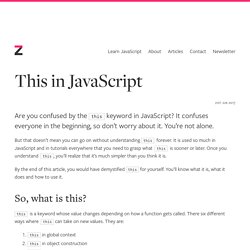

What is `this`? The Inner Workings of JavaScript Objects. JavaScript is a multi-paradigm language that supports object-oriented programming and dynamic binding.

Dynamic binding is a powerful concept which allows the structure of your JavaScript code to change at runtime, but that extra power and flexibility comes at the cost of some confusion, and a lot of that confusion is centered around how this behaves in JavaScript. Dynamic binding is the process of determining the method to invoke at runtime rather than compile time. JavaScript accomplishes that with this and the prototype chain. In particular, the meaning of this inside a method is determined at runtime, and the rules change depending on how that method was defined. Let’s play a game. Before you continue, write down your answers. Let’s start with the first case and work our way down.
Why? Obj.getThis2() gets its binding via the normal method invocation process. Obj.getThis2.call(a) is a little trickier. Write your answers down before you continue. Ready? A Potterhead’s Guide to JavaScript’s ‘this’ Keyword. The JavaScript keyword “this” can be incredibly mind-boggling for novice developers, such as myself.

Misjudging the value of this can drastically impact the functionality of an object-oriented JavaScript application. Why is it so challenging to get a handle on, you ask? Because every time this emerges from the dark, confined spaces in which it hides — like a wardrobe, for instance — it takes on a different form. Something else you may find hidden inside a wardrobe is a Boggart, a shape-shifting creature which will change its form depending on the person it has encountered, and ultimately take on the form of what that particular person fears the most. this is JavaScript’s Boggart, in that the value of this changes based on its execution context.
Outside of any function, this refers to the global object, or the window in web browsers. When inside an instance method, this will take on the value of the object which received the method call, like a Boggart encountering a person. The Simple Guide to “This” in JavaScript - codeburst. The last guide you will ever need for understanding this in JavaScript.

We will explore what this is, and how to determine what it points to. — Prerequisites — Definitions — — Basics of This — Examples of This — — Default This Binding — — Implicit Binding — — Explicit Binding — — Explicit Binding via Arguments — — Lexical Binding with Arrow Functions — — The ‘New’ Operator — The Simple Rules to Determine This — — 1. Using an Arrow Function? (lexical) — — 2. Using the New Operator?
I’m making a light assumption that you’ve already encountered this before or at least have heard of it. Some definitions of keywords used in this tutorial. The Magic Of this Keyword - JavaScript Teacher - Medium. JavaScript borrows this keyword from C++, where it is used to point to an instance of an object from within its own class definition.

There is absolutely no confusion about this keyword in C++ because this keyword is never used for any other intent than to point to an instance of an object from its constructor! The original designer of JavaScript decided to tie a secondary feature to this keyword. Not only is it used to point to an instance of an object from its own constructor or its methods (hence, this) it is also used to keep track of execution context — which is often based on where a function was called from. (1) Understanding Functions and 'this' In The World of ES2017. This in JavaScript. 21st Jun 2017 Are you confused by the this keyword in JavaScript?

It confuses everyone in the beginning, so don’t worry about it. You’re not alone. But that doesn’t mean you can go on without understanding this forever. Gentle explanation of this keyword in JavaScript. ES3, Chap 3. — La valeur de this en JavaScript. Ce billet fait partie de la collection ES3 dans le détail et en constitue le Chapitre 3.

Dans cet article nous allons discuter d'une propriété supplémentaire liée aux contextes d'exécution : le mot-clé this. Introduction Beaucoup de développeurs associent le mot-clé this à ce qu'il est dans la programmation orientée objet, à savoir, une référence à un objet nouvellement créé par un constructeur. En JavaScript ce concept existe aussi, cependant il ne se limite pas uniquement à la référence d'un objet instancié. Apprendre à utiliser la valeur de this en JavaScript. Les choses sont plus intéressantes quand this est utilisé à l'intérieur d'une fonction.

Ce cas est le plus compliqué et est la cause de beaucoup de peines. La première (et sûrement la plus importante) chose à savoir sur le mot-clé this dans cette déclinaison de code est qu'ici elle n'est pas statiquement liée à la fonction. Comme mentionné plus haut, la valeur de this est déterminée pendant la phase d'entrée dans le contexte et dans le cas d'une fonction, cette valeur peut être complètement différente à chaque fois (à chaque appel). Cependant, une fois la phase d'exécution du code en cours, la valeur de this est immuable.
C'est-à-dire qu'il n'est pas possible de lui affecter une nouvelle valeur, car ce n'est pas une variable (par opposition au langage de programmation Python, par exemple, dont l'objet self est explicitement défini et peut donc être redéfini à souhait pendant la phase d'exécution) : JavaScript’s “this” Explained By Starting A High School Band – CodeAnalogies Blog. If you have ever been in a band, had a friend that started a band or seen a corny 80s movie about starting a band, then you can understand the concept of “this” in JavaScript.

When you are reading over some JavaScript, and you come across the this keyword, the steps you need to take in order to figure out its value seem obvious. You might be thinking, “I just need to find the function that contains this, and then I will know what it is referring to!” In the example above, for example, this.name refers to the name “myBand”. This seems easy! But, as you learn more JavaScript concepts, like closures and callbacks, you will quickly find that this does not behave like you would expect. So, I wanted to create a visual explanation of how this works in JavaScript. Your band has 4 membersYou play three types of gigs- you play at bars, school competitions and public events in town.Your team can play all types of music, so you try to choose the right songs to match the audience.
Gordonmzhu/cheatsheet-js: A super condensed JavaScript reference for Watch and Code students.